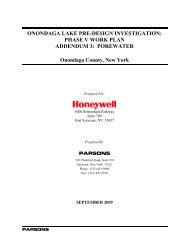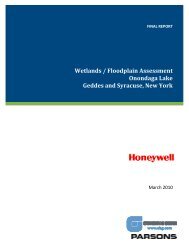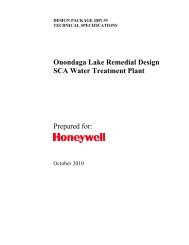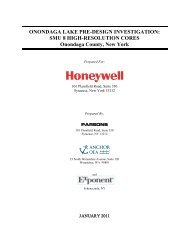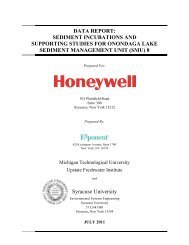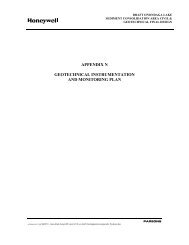Phase 1B Underwater Archaeological Report for the Onondaga ...
Phase 1B Underwater Archaeological Report for the Onondaga ...
Phase 1B Underwater Archaeological Report for the Onondaga ...
Create successful ePaper yourself
Turn your PDF publications into a flip-book with our unique Google optimized e-Paper software.
FINAL<br />
<strong>Phase</strong> IB <strong>Underwater</strong> <strong>Archaeological</strong> Resources <strong>Report</strong> <strong>for</strong> <strong>Onondaga</strong> Lake Superfund Site<br />
scows were also used as working plat<strong>for</strong>ms. The term scow is frequently used interchangeably with <strong>the</strong><br />
term barge, but this is not technically correct. “Scow” denotes <strong>the</strong> shape of a vessel’s hull, while<br />
“barge” implies that a vessel is not self-propelled. Many scows were also barges, but many barges were<br />
not scows. The hull shape of a scow was flat-bottomed with vertical sides, and sloping or raked ends.<br />
The ends were normally straight, but angled at about 45 degrees. Most scows were decked, with <strong>the</strong><br />
hold serving as a buoyant pontoon that supported <strong>the</strong> cargo on <strong>the</strong> deck. 105 The hold contained a<br />
number of <strong>for</strong>e-and-aft and transverse structures used to support <strong>the</strong> deck and cargo above.<br />
Rock Scows (1819 to present)<br />
Rock scows, also known as bulkhead scows, were designed to carry large quantities of crushed stone,<br />
sand, and o<strong>the</strong>r loose materials. The materials were placed on <strong>the</strong> main deck and held in place by<br />
timber bulkheads at <strong>the</strong> bow and stern. These timber bulkheads were <strong>the</strong> defining feature of this vessel<br />
type, although <strong>the</strong>y also tended to be built stronger than o<strong>the</strong>r scow types because of <strong>the</strong> heavy loads<br />
carried on deck.<br />
Dump Scows (1820 to 1950s)<br />
Various styles of dump scows were designed <strong>for</strong> <strong>the</strong> purpose of holding and dumping of fill. A basic<br />
description is a vessel with an internal flotation and a trap door bottom used in canal construction.<br />
Brouwer describes two primary types: <strong>the</strong> hopper barge and <strong>the</strong> side dumping scow. The hopper barge<br />
has dimensions of 133 feet (40.5m) long, by 35 feet (10.7m) wide, with a 14 feet (4.3m) depth of hold.<br />
The barge had curved ends <strong>for</strong>ming one quarter of a circle from keel to deck. There is a hatch that is<br />
closed by a pair of timber doors that are held closed by chain bridles. Once <strong>the</strong> contents of <strong>the</strong> hopper<br />
were dumped, <strong>the</strong> doors could <strong>the</strong>n be closed. The side dump scow is described as a standard scow hull<br />
with a raked bow and stern. It has three longitudinal bulkheads located at one-quarter, one half and<br />
three quarter points of <strong>the</strong> width of <strong>the</strong> vessel. The deck was sloped 45 degrees on ei<strong>the</strong>r side, with<br />
four bays separated by bulkheads. Dumping would have been done by opening <strong>the</strong> bays. 106<br />
Derrick Lighters (1820 to present)<br />
Derrick Lighters were structurally almost identical to open deck scows, but were fitted with hoisting<br />
equipment. This equipment was normally in <strong>the</strong> <strong>for</strong>m of one or two spars. One spar was mounted in<br />
<strong>the</strong> stern just <strong>for</strong>ward of <strong>the</strong> cabin, while <strong>the</strong> second was mounted in <strong>the</strong> bow. The spars were fitted<br />
with booms to facilitate <strong>the</strong> loading and unloading of cargo. 107<br />
Dredges<br />
The canal system required continual waterway maintenance and deepening, making dredges a common<br />
sight on <strong>the</strong> canals from <strong>the</strong> 1820s into <strong>the</strong> mid-twentieth century (Figure 22). Dredges were typically<br />
unpowered vessels with scow-shaped hulls. Many were equipped with spuds, vertical posts which could<br />
be raised and lowered to hold a vessel in place. Various dredging mechanisms, typically steam driven,<br />
were employed resulting in vessel types such as spoon dredges, wheel dredges, clam shell dredges,<br />
bucket dredges, ladder dredges and cutter head dredges.<br />
32



